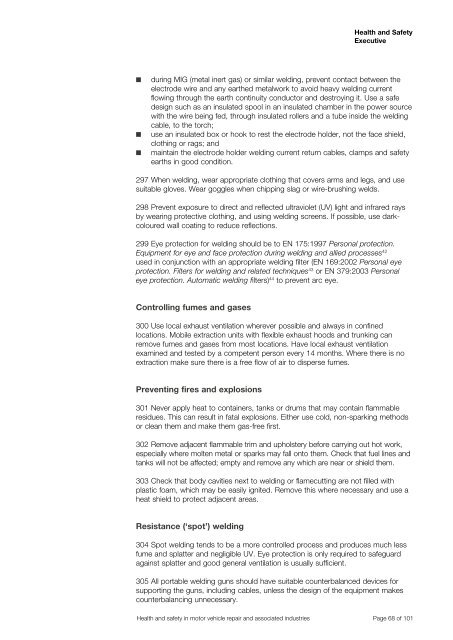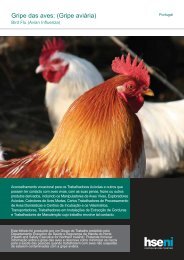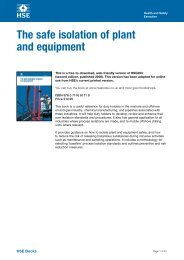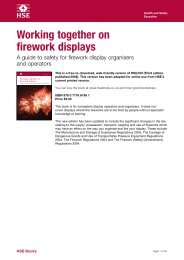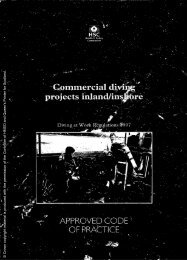Health and safety in motor vehicle repair and associated industries
Health and safety in motor vehicle repair and associated industries
Health and safety in motor vehicle repair and associated industries
Create successful ePaper yourself
Turn your PDF publications into a flip-book with our unique Google optimized e-Paper software.
n<br />
n<br />
n<br />
<strong>Health</strong> <strong>and</strong> Safety<br />
Executive<br />
dur<strong>in</strong>g MIG (metal <strong>in</strong>ert gas) or similar weld<strong>in</strong>g, prevent contact between the<br />
electrode wire <strong>and</strong> any earthed metalwork to avoid heavy weld<strong>in</strong>g current<br />
flow<strong>in</strong>g through the earth cont<strong>in</strong>uity conductor <strong>and</strong> destroy<strong>in</strong>g it. Use a safe<br />
design such as an <strong>in</strong>sulated spool <strong>in</strong> an <strong>in</strong>sulated chamber <strong>in</strong> the power source<br />
with the wire be<strong>in</strong>g fed, through <strong>in</strong>sulated rollers <strong>and</strong> a tube <strong>in</strong>side the weld<strong>in</strong>g<br />
cable, to the torch;<br />
use an <strong>in</strong>sulated box or hook to rest the electrode holder, not the face shield,<br />
cloth<strong>in</strong>g or rags; <strong>and</strong><br />
ma<strong>in</strong>ta<strong>in</strong> the electrode holder weld<strong>in</strong>g current return cables, clamps <strong>and</strong> <strong>safety</strong><br />
earths <strong>in</strong> good condition.<br />
297 When weld<strong>in</strong>g, wear appropriate cloth<strong>in</strong>g that covers arms <strong>and</strong> legs, <strong>and</strong> use<br />
suitable gloves. Wear goggles when chipp<strong>in</strong>g slag or wire-brush<strong>in</strong>g welds.<br />
298 Prevent exposure to direct <strong>and</strong> reflected ultraviolet (UV) light <strong>and</strong> <strong>in</strong>frared rays<br />
by wear<strong>in</strong>g protective cloth<strong>in</strong>g, <strong>and</strong> us<strong>in</strong>g weld<strong>in</strong>g screens. If possible, use darkcoloured<br />
wall coat<strong>in</strong>g to reduce reflections.<br />
299 Eye protection for weld<strong>in</strong>g should be to EN 175:1997 Personal protection.<br />
Equipment for eye <strong>and</strong> face protection dur<strong>in</strong>g weld<strong>in</strong>g <strong>and</strong> allied processes 42<br />
used <strong>in</strong> conjunction with an appropriate weld<strong>in</strong>g filter (EN 169:2002 Personal eye<br />
protection. Filters for weld<strong>in</strong>g <strong>and</strong> related techniques 43 or EN 379:2003 Personal<br />
eye protection. Automatic weld<strong>in</strong>g filters) 44 to prevent arc eye.<br />
Controll<strong>in</strong>g fumes <strong>and</strong> gases<br />
300 Use local exhaust ventilation wherever possible <strong>and</strong> always <strong>in</strong> conf<strong>in</strong>ed<br />
locations. Mobile extraction units with flexible exhaust hoods <strong>and</strong> trunk<strong>in</strong>g can<br />
remove fumes <strong>and</strong> gases from most locations. Have local exhaust ventilation<br />
exam<strong>in</strong>ed <strong>and</strong> tested by a competent person every 14 months. Where there is no<br />
extraction make sure there is a free flow of air to disperse fumes.<br />
Prevent<strong>in</strong>g fires <strong>and</strong> explosions<br />
301 Never apply heat to conta<strong>in</strong>ers, tanks or drums that may conta<strong>in</strong> flammable<br />
residues. This can result <strong>in</strong> fatal explosions. Either use cold, non-spark<strong>in</strong>g methods<br />
or clean them <strong>and</strong> make them gas-free first.<br />
302 Remove adjacent flammable trim <strong>and</strong> upholstery before carry<strong>in</strong>g out hot work,<br />
especially where molten metal or sparks may fall onto them. Check that fuel l<strong>in</strong>es <strong>and</strong><br />
tanks will not be affected; empty <strong>and</strong> remove any which are near or shield them.<br />
303 Check that body cavities next to weld<strong>in</strong>g or flamecutt<strong>in</strong>g are not filled with<br />
plastic foam, which may be easily ignited. Remove this where necessary <strong>and</strong> use a<br />
heat shield to protect adjacent areas.<br />
Resistance (‘spot’) weld<strong>in</strong>g<br />
304 Spot weld<strong>in</strong>g tends to be a more controlled process <strong>and</strong> produces much less<br />
fume <strong>and</strong> splatter <strong>and</strong> negligible UV. Eye protection is only required to safeguard<br />
aga<strong>in</strong>st splatter <strong>and</strong> good general ventilation is usually sufficient.<br />
305 All portable weld<strong>in</strong>g guns should have suitable counterbalanced devices for<br />
support<strong>in</strong>g the guns, <strong>in</strong>clud<strong>in</strong>g cables, unless the design of the equipment makes<br />
counterbalanc<strong>in</strong>g unnecessary.<br />
<strong>Health</strong> <strong>and</strong> <strong>safety</strong> <strong>in</strong> <strong>motor</strong> <strong>vehicle</strong> <strong>repair</strong> <strong>and</strong> <strong>associated</strong> <strong>in</strong>dustries Page 68 of 101


